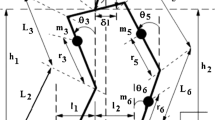Abstract
The angular positions of the lower limb joints play important roles on the energy consumption and stability for the bipedal walking up slopes. In this study, the ranges of angular position of lower limb joints are confined and the velocity of swing foot is zero when it touches the ground, which result in the construction of the impactless planar bipedal model. Motion/force control scheme combined with genetic algorithm (GA) is used to ensure stability and low energy cost of bipedal walking at different speeds. The optimized parameters of gaits are obtained by GA, which include walking speed, step length and the maximum height of swing ankle joint. The results demonstrate that more energy is consumed when the optimal walking speed increases for the biped walking on slopes with the same gradient. There are no great differences in optimal step length of the biped when the walking speed changes. The optimal step length declines as the slope increases at the same walking speed. The ankle torques of standing leg have higher values in single support phase at fast speed compared to those at slow and normal speeds. Modifications of boundary conditions can not only be used to realize the stable walking for the biped negotiating slopes, but also be applied to analyze bipedal gaits for walking on stairs and uneven surfaces.












Similar content being viewed by others
References
Blajer W, Schiehlen W (1992) Walking without impacts as a motion/force control problem. J Dyn Syst Meas Control 114(4):660–665. https://doi.org/10.1115/1.2897738
Dau VH, Chew CM, Poo AN (2009) Achieving energy-efficient bipedal walking trajectory through GA-based optimization of key parameters. Int J Humanoid Robot 6(4):609–629. https://doi.org/10.1142/s0219843609001905
Gandomi AH, Kashani AR, Mousavi M, Jalalvandi M (2017) Slope stability analysis using evolutionary optimization techniques. Int J Numer Anal Meth Geomech 41(2):251–264. https://doi.org/10.1002/nag.2554
Ge Y, Wang L, Li Z (2015) Hybrid motion/force control of biped robots considering force optimization. In: 2015 IEEE international conference on cyber technology in automation, control, and intelligent systems (CYBER). pp 520–524. https://doi.org/10.1109/CYBER.2015.7287993
Gong L (2013) Impactless biped walking on stairs. In: ASME 2013 international design engineering technical conferences and computers and information in engineering conference (IDETC/CIE 2013), Portland, OR, information in engineering conference. https://doi.org/10.1115/DETC2013-12237
Gong L, Schiehlen W (2013) Impactless biped walking on a slope. Theor Appl Mech Lett 3(1):013002. https://doi.org/10.1063/2.1301302
Gumuscu A, Karadag K, Tenekeci ME, Aydilek IB (2017) Genetic algorithm based feature selection on diagnosis of Parkinson disease via vocal analysis. In: 2017 25th signal processing and communications applications conference (SIU), Antalya, Turkey. https://doi.org/10.1109/SIU.2017.7960384
Juang CF, Yeh YT (2018) Multiobjective evolution of biped robot gaits using advanced continuous ant-colony optimized recurrent neural networks. IEEE Trans Cybern 48(6):1910–1922. https://doi.org/10.1109/tcyb.2017.2718037
Kang Q, Wang J, Zhou M, Ammari AC (2016) Centralized charging strategy and scheduling algorithm for electric vehicles under a battery swapping scenario. IEEE Trans Intell Transp Syst 17(3):659–669. https://doi.org/10.1109/TITS.2015.2487323
Khadiv M, Moosavian SAA, Yousefi-Koma A, Sadedel M, Mansouri S (2017) Optimal gait planning for humanoids with 3D structure walking on slippery surfaces. Robotica 35(3):569–587. https://doi.org/10.1017/s0263574715000715
Kurz T, Eberhard P, Henninger C, Schiehlen W (2010) From Neweul to Neweul-M2: symbolical equations of motion for multibody system analysis and synthesis. Multibody Syst Dyn 24(1):25–41. https://doi.org/10.1007/s11044-010-9187-x
Safa AT, Mohammadi S, Hajmiri SE, Naraghi M, Alasty A (2016) How local slopes stabilize passive bipedal locomotion? Mech Mach Theory 100:63–82. https://doi.org/10.1016/j.mechmachtheory.2016.01.013
Sarkar A, Dutta A (2015) 8-DoF biped robot with compliant-links. Robot Auton Syst 63:57–67. https://doi.org/10.1016/j.robot.2014.09.014
Schiehlen W (2005) Energy-optimal design of walking machines. Multibody Syst Dyn 13(1):129–141. https://doi.org/10.1007/s11044-005-4068-4
Singh R, Chaudhary H, Singh AK (2017) Defect-free optimal synthesis of crank-rocker linkage using nature-inspired optimization algorithms. Mech Mach Theory 116:105–122. https://doi.org/10.1016/j.mechmachtheory.2017.05.018
Taherkhorsandi M, Castillo-Villar KK, Mahmoodabadi MJ, Janaghaei F, Mortazavi Yazdi SM (2015) Optimal sliding and decoupled sliding mode tracking control by multi-objective particle swarm optimization and genetic algorithms. In: Azar AT, Zhu Q (eds) Advances and applications in sliding mode control systems, vol 576. Studies in computational intelligence. Springer, Cham, pp 43–78. https://doi.org/10.1007/978-3-319-11173-5_2
Zhang YN, Wang XS, Xin YH, Wu Y, Kang M, Wang XC (2017) Quadruped robot leg optimization based on a multi-objective genetic algorithm. Mechanika 23(6):881–890. https://doi.org/10.5755/j01.mech.23.6.19854
Acknowledgements
The author Lulu Gong would like to express her sincere appreciation to Prof. Werner Schiehlen in University of Stuttgart for his talent and valuable supervision which made the successful completion of this study possible. This work was supported by the National Natural Science Foundation of China (Grant No. 11402176, 81570760 and 31771283), the National Key Research and Development Program of China (Grant No. 2017YFA0103900, 2017YFA0103902 and 2017YFA0103904), Ministry of Science and Technology of China (Grant No. 2016ZY05001905 and 2017ZY050105), One Thousand Youth Talents Program of China to Chao Zhang, the Program for Professor of Special Appointment (Eastern Scholar) at Shanghai Institutions of Higher Learning (Grant No. A11323 to Chao Zhang), the Shanghai Rising-Star Program (Grant No. 15QA1403600), and the Fundamental Research Funds for the Central Universities of Tongji University to Lulu Gong and Chao Zhang.
Author information
Authors and Affiliations
Corresponding authors
Additional information
Publisher's Note
Springer Nature remains neutral with regard to jurisdictional claims in published maps and institutional affiliations.
Rights and permissions
About this article
Cite this article
Gong, L., Zhao, R., Liang, J. et al. Periodic motion generation for the impactless biped walking up slopes via genetic algorithm. Nat Comput 19, 743–755 (2020). https://doi.org/10.1007/s11047-019-09733-x
Published:
Issue Date:
DOI: https://doi.org/10.1007/s11047-019-09733-x




